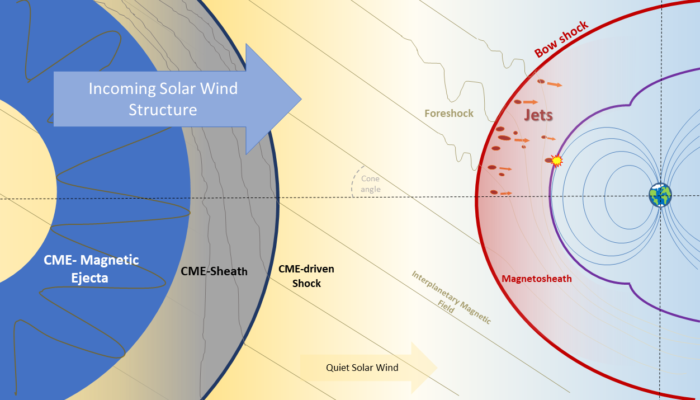Life in academia can be complex, involving handling multiple roles while developing and sustaining a successful career. Therefore, it can be challenging to balance research responsibilities with other commitments. Understandably, effective time management is essential for researchers to be productive and to achieve their goals, without sacrificing other important matters in life. The Early Career ...[Read More]
Exploring Magnetosheath Jets and their dependence on Solar Wind structures
Dayside of the Earth’s magnetic field Our understanding of the relationship between Earth’s magnetic field and the particles from the Sun that constantly bombard it, known as the solar wind, has significantly advanced in recent decades. The availability of numerous spacecraft measurements has provided valuable insights into this interaction. The solar wind, composed of high-speed particles c ...[Read More]
Why faculae “vanish” on active Suns
The Earth’s primary energy source is the radiative energy flux (i.e., the Total Solar Irradiance, TSI) from the Sun. Understanding the TSI or the solar irradiance output in particular wavelengths is important, as it is crucial for sustaining life of metabolisms on Earth and in answering the question of how life emerged on Earth. It has been shown that magnetic activity on the solar surface is one ...[Read More]
Events organised by the ST-ECS Team during EGU23
The General Assembly is around the corner, and we would like to advertise the events the early-career scientist (ECS) Team of our Division have been preparing to create networking opportunities for ECSs. Joint picnic for ST/PS/AS/EMRP ECSs (in-person only) When? Monday 24 April, 12:30–13:45 CEST Where? Meeting near the main entrance of the Austrian Center Vienna (ACV), before heading out to the Do ...[Read More]
Employing J burst observations made by LOFAR to determine the properties of large coronal loops
Large coronal loops around one solar radius in altitude are an important connection between the solar wind and the low solar corona. However, their plasma properties are not well studied, as standard X-ray and UV techniques are not suited to these low-density environments. How does temperature, pressure, and magnetic field strength evolve along these loops? Observable structures in radio emission ...[Read More]
ST-ECS Networking Campfire: How to select collaborators or your future research group?
Whether you are about to start working on your thesis, or you are ready to join a new research group, deciding which PI and which group to join is not something to be taken lightly. One first has to go through the process of understanding their goals and wishes, what the PI/group can offer, and whether they will fit in. The Early Career Scientists (ECS) team of the Solar-Terrestrial (ST) division ...[Read More]
The impacts of space weather on the mid-latitude upper atmosphere
The upper atmosphere of Earth is constantly being impacted by the flow of charged particles being released from the sun. This flow (the solar wind) carries with it a magnetic field which distorts and reshapes that of Earth, ultimately resulting in a large amount of electromagnetic space weather energy being channelled into the polar regions. One of the most frequently observed outcomes of this pro ...[Read More]
Meet the Early Career Scientists team of our division!
Hi, this is your ST-ECS team. We are a group of Early Career Scientists (ECSs) of the Solar-Terrestrial (ST) division, and we enjoy organizing events and activities with and for ST-ECS, both during the EGU General Assembly and throughout the year. Our aim is to increase the visibility of ECSs and provide you with opportunities for networking. Currently the team is formed by: Dr. Maxime Grandin Max ...[Read More]
Events organised by the ST Early-Career Scientist (ECS) Team during EGU22: We would like your feedback!
Now that EGU22 is over, it is time to gather some feedback! While you can provide your comments and suggestions on the General Assembly as a whole via the dedicated form available through the EGU22 website (see “Feedback” tab in https://www.egu22.eu/), the ST Division’s Early-Career Scientist (ECS) Team would very much appreciate getting feedback on the various events they have o ...[Read More]
Reflection after the investigation of the direct First Parker Solar Probe Observation of the Interaction of Two Successive ICMEs
In Heliophysics there is a scarcity of in-situ buoys that allows us to monitor and track the solar wind changes in our Sun’s atmosphere, the heliosphere. NASA’s Parker Solar Probe (PSP) mission is one of those buoys that, together with Solar Orbiter (SolO, ESA/NASA Collaboration), is bringing a breath of fresh air in the effort to fully characterize the solar wind and study the evolution of the em ...[Read More]





